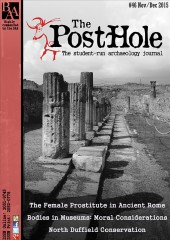Prostitution is often stated as being the oldest profession (Gonsalves 2008, 157). Regardless of the questionable accuracy of this statement, prostitution is an ancient business. This paper will specifically discuss the identity of the female prostitute in Ancient Rome. For clarification, the definition of prostitute used will be: a female who is not a slave and who works within the sex industry. It should also be noted that the entire Roman Empire will not be discussed; local cultural variation presents more alternatives than the scope of this paper allows for. Therefore Rome itself, as well as Pompeii, will be looked at. In presenting an identity of the Ancient Roman prostitute, the difficulties in studying female prostitutes from this time period will be presented. Various interwoven identities will then be discussed, starting with the legal definition given to prostitutes. Then Roman sexual definitions, and their impact on the identity of prostitutes, will be explored. Thirdly, the identity of a prostitute as a woman will be examined.
Historically, work on Roman society has been understood along the lines of 19th century colonial concepts of male power. This resulted in an understanding of Roman life without a female perspective (Olson 2006, 187). For instance, an exploration of the Roman female narrative requires different chronological divisions to the traditional ones, which present changes in society from a male perspective (Bauman 1992, 2). As a result, some scholars have begun to look at female and family issues in Ancient Rome to try and fill this gap (e.g. Allison 2007; Rawson 1986; Rawson 1996). One of the major obstacles for the visibility of women in this period is the lack of documentary evidence. Texts from the Roman period arguably represent the view of the male elite who were creating the documents. While women may be discussed, it is from this point of view, showing women as society sees them rather than how women identify themselves (Allison 2007, 345; Thom 1992, 46). This results in a lack of evidence for the lives of women from this period (Hallett 1993, 52), including prostitutes.
The first aspect of an Ancient Roman prostitute’s identity that will be looked at is that of their legal status as infames, and the boundaries this creates with other groups in society. Edwards states that not only was the label of infamis given to prostitutes, but also to gladiators, actors and other public performers. This designation meant that members of these professions were restricted from various aspects of public life, such as standing for election to magistrate or being allowed to speak in a court of law. They were also viewed as symbols of shame and allowed to be beaten, mutilated and violated by others without fear of punishment (1997, 66). Indeed, a husband was allowed to kill his wife’s lover if they were infames on the condition he then divorced her within three days and began the case against her for adultery (Edwards 1993, 38). The legal restriction on infames overlaps with the legal restrictions already placed on women, so this likely had less of an effect on female than on male prostitutes.
However, while the designation of infamia may not appear to have much of an additional effect on a female prostitute in terms of legal restrictions, it was significant in other ways. The first is that the label of infamia is carried for life. Other similar punishments, such as those imposed on disgraced soldiers or criminals, are only in place for a time (Edwards 1997, 67). There is also the effect this legal status has on those around them. Pimps are likewise defined as infames, and if there is an attempt to convict a woman of adultery which fails, the husband can then be prosecuted for pimping and carry the label of infamis himself (Gardner 1986, 90; Olson 2006, 193-194). There are also cases where it is suggested some elite women registered themselves as a prostitute to avoid the fine for adultery (Duncan 2006, 255). This may have had the effect that the husband would be disgraced alongside the wife, and this being the case, there may be more than simple practical economic reasoning behind this. The effect on a husband whose wife claimed to be a prostitute, whether this was actually the case or not, was to be identified alongside them as infames. An unmarried prostitute could marry a free man, but again he would have to carry the infamis identity once they were married. Augustus later brought in legislation to ban any woman who was, or had been, a prostitute from ever marrying a freeborn male citizen (Duncan 2006, 255). This has the result of identifying the prostitute as one that has been ostracised from society.
Prostitutes and actors are seen as the worst of the infames (Duncan 2006, 255), and are often viewed as being the same. Both their jobs are seen as ‘faking it’ for money, and are therefore interchangeable (Duncan 2006, 256:270). Therefore, the identity of a prostitute may not be focused specifically around their job in the sex industry, rather their level of infamia and the fakery innate in the profession. Caution should be given when assuming that legal designations, such as infamia, relate to social attitudes. Social attitudes are often more fluid and complex than is represented in legal documentation (Edwards 1997, 71). An example of this is the repeated creation of legislation to try and stop the noble classes from taking part in occupations that carry the infamia mark, and to try and stop them from marrying infames. The fact that numerous legislations were brought in suggests it was unsuccessful (Duncan 2006, 256).
One of the major reasons for defining prostitutes as infames is to create a boundary between them and the rest of society. In a society where honour was held in high esteem, prostitution could be used as an example of what not to be, providing a contrast to the honourable in society (Edwards 1997, 67). It has been suggested that another way in which the sex industry is further set aside from society is through the concept of ‘moral zoning’ in city planning. Much of the literature on this uses Pompeii as an example due to its unique preservation, which makes it ideal for studying structures in the wider context of a city. Brothels are a part of Pompeii that has been given a lot of attention, and this may be in part due to the relatively high number of brothels. It has been suggested there could be thirty five in the city, if not more, although this number is contested (McGinn 2006, 161). One of the ways in which the placement of these brothels has been interpreted is moral zoning, by deliberately placing them in hidden areas, although keeping them central (McGinn 2006, 162; Wallace-Hadrill 1995, 51-52). Lawrence (2007, 86) has argued that their placement has also been designed to keep them away from elite children. McGinn (2006, 162) agrees that the visibility of brothels may have been deliberately disguised, pointing to the example of the Roman port city of Ostia where there appear to be no visible brothels, although it seems unlikely there was no sex industry.
This adds to the difficulty experienced by archaeologists in recognising prostitutes and the industry as a whole (McGinn 2006, 163). However, moral zoning of a city may be a little simplistic. While defining social class is important in Rome, the physical segregation of elites and the poor in city planning is not so clear cut. While elites do tend to all live in the same area, they are not necessarily cut off from other ranks in society. This being the case, it can be suggested that brothels would not need to be segregated from other groups in society (McGinn 2006, 163). It is also simplistic to attempt to understand the physical presence of prostitution purely through the placement of brothels. There are many public areas, such as the circus or baths, where prostitution could take place (McGinn 2006, 162). Because of the difficulties in being able to define a brothel, and the public nature of a prostitute’s work, archaeological evidence is difficult to find.
A further feature of a prostitute’s identity is described through Ancient Roman attitudes towards sexuality. Sexuality in a modern Western definition tends to fall into categories of gender preference. In simplified terms, this is across an axis of heterosexual and homosexual, although there are many shades within this spectrum. The Ancient Roman definition follows different rules. The axis used is that of active (vir) and passive (cinaedus) (Parker 1997, 47). The role of the vir partner is that of penetration and sexual enjoyment. In contrast cinaedus is a passive role, designed to allow the vir to experience their pleasure through receiving their penetration. Therefore the definition of someone’s sexuality falls along these lines, regardless of the gender they are having sex with. Bisexuality was allegedly common, although this definition would have made no sense at the time. The idea of a man sleeping with another man does not bring into question the masculinity of either. The penetrator (vir) is still seen as masculine. Indeed the masculinity of an individual could be asserted by sleeping with cinaedus men (Parker 1997, 55). A woman who takes on the active vir role is seen as unusual and masculine in her enjoyment of sex, and is often identified as a prostitute or adulteress and is socially unacceptable (Parker 1997, 58).
In order to set them aside from normal female society, a prostitute or adulteress was classed as togata, meaning she wore a toga: another symbol of masculinity. This adds yet another layer to the identity of the prostitute. The identity of togata in describing a woman does not always make a distinction between adulteress and prostitute, suggesting they may be interchangeable in this regard in a similar way as prostitutes and actors in their given roles of infames (Olsen 2006, 192-193). Ancient Rome is not the only period or place where female prostitutes wore men’s clothing to represent their masculine sexual appetite. Prostitutes in Elizabethan England and in 16th century Venice also wore men’s clothing for this reason (Duncan 2006, 270; Garber 1992, 86). A woman wearing a toga, as well as representing masculinity in sexual preference, also represents a public figure. Noble women in Rome did not go out in public alone, or conduct business in the public eye. A prostitute is the opposite of this, being visible in public and always alone. Therefore, she again acted more like a male would have than a female, who would stay at home or go out with attendants (Duncan 2006, 270). Thus, the term togata represents the identity of a prostitute on two levels: that of a woman with a sexual preference that goes against the norm and that of someone who works in public and goes out alone. However, while the toga was a symbol of men and masculinity, it is not the case that all men would have always worn one. Poorer male citizens may not have been able to afford one, and they are not necessarily functional items of clothing, being both cumbersome and hot. Augustus legislated to ensure the upper classes wore togas, which suggests even those who could afford it were not always wearing them (Olson 2006, 188). In the same way, defining a woman as togata does not necessarily mean she was literally wearing a toga. The definition is more a moral description than a literal one (Olson 2006, 196).
The female version of the toga, representing the ideal of femininity, is the stola, worn over a tunic (Olson 2006, 189). Like the toga, the stola was a brief fashion and was not worn throughout the Ancient Roman period. There are descriptions of elite women discarding the stola to advertise themselves sexually, however, the dominance of male literature on this matter does little to represent the actual thoughts of women. The stola, like the toga, may well have been abandoned as an impractical and hot garment, rather than as an attempt to proclaim sexual willingness (Olson 2006, 197:200). While Olson is rightly critical of the male dominated understanding of female clothing, a somewhat simplistic understanding of a prostitute’s dressing in modest clothing is given. She questions why a prostitute would do this as it may be bad for business (Olson 2006, 198). This ignores one of the identities rarely discussed in terms of the prostitute: that of a woman. As discussed earlier, there are laws allowing the abuse of prostitutes. However there is legislation stating that if the woman turns out not to be a prostitute, the abuser can be prosecuted (Olson 2006, 197). While literature complaining of noble women and prostitutes becoming indistinguishable may be down to the male-dominated bias in the literature exaggerating the lagging morals of noble women, legislation such as this suggests that women’s fashion is mutually inspired by noble women and prostitutes, such as Coan silk being worn (Olson 2006, 197), showing the identity of the prostitute as a woman. The aforementioned fears of women and prostitutes dressing similarly also suggests the idea of the identity of prostitutes as women. That a prostitute may be willing to dress in a way that is bad for business suggests she may be presenting her identity of a woman over that of a prostitute.
To conclude, there is not one simple definition of the identity of the female prostitute in Ancient Rome. Rather, she has a multi-layered identity. In unpicking this identity, it needs to be recognised that the male dominated literature from the time, and the traditionally male dominated research of the period, does not give a highly visible picture of women, and this is especially true for prostitutes. Prostitution is also difficult to define archaeologically through material culture. The first identity presented in this paper is a legal designation: infamia. This presents prostitutes to society as dishonourable and untrustworthy and worthy of segregation from society. The second identity presented is that of vir, the active partner in sex, alongside which is the label of togata, which like like infamia, is interchangeable with an adulteress. This essay also describes the identity of the prostitute as a woman who is a public figure and works alone. The third identity presented is that of a woman. This is shown through clothing and a prostitute presenting herself in a way that is not beneficial for her business, but reinforces her identity.
Bibliography
- Allison, P. M. (2007) 'Engendering Roman Domestic Space'. In Building Communities: House, Settlement and Society in the Aegean and Beyond, ed. by Westgare, R., Fisher, N. & Whitley, J. London: The British School at Athens, 343-350
- Bauman, R. A. (1992) Women and Politics in Ancient Rome. London: Routledge
- Duncan, A. (2006) 'Infamous Performers: Comic Actors and Female Prostitutes in Rome'. In Prostitutes and Courtesans in the Ancient World, ed. by Faraone, C. & McClure, L. Wisconsin: The University of Wisconsin Press, 252-273
- Edwards, C. (1997) 'Unspeakable Professions: Public Performance and Prostitution in Ancient Rome'. In Roman Sexualities, ed. by Hallett, J. P. & Skinner, M. B. Princeton University Press: New Jersey, 66-98
- Edwards, C. (1993) The Politics of Immorality in Ancient Rome. Cambridge: Cambridge University Press
- Garber, M. B. (1992) Vested Interests: Cross-Dressing and Cultural Anxiety. London: Routledge
- Gardner, J. F. (1986) Women in Roman Law & Society. London: Croom Helm Ltd
- Gonsalves, L. (2008) Women and Human Rights. New Delhi: APH Publishing
- Hallett, J. P. (1993) 'Feminist Theory, Historical Periods, Literary Canons, and the Study of Greco-Roman Antiquity'. In Feminist Theory and the Classics, ed. by Rabinowitz, N. C. & Richlin, A. London: Routledge, 44-74
- Laurence, R. (2007) Roman Pompeii: Space and Society 2 edn. London: Routledge
- McGinn, T. (2006) 'Zoning Shame in the Roman City'. In Prostitutes and Courtesans in the Ancient World, ed. by Faraone, C. A. & McClure, L. Wisconsin: The University of Wisconsin Press, 161-176.
- Olson, K. (2006) 'Matrona and Whore: Clothing and Definition in Roman Antiquity'. In Prostitutes and Courtesans in the Ancient World, ed. by Faraone, C.A. & McClure, L. Wisconsin: The University of Wisconsin Press, 186-204.
- Parker, H. N. (1997) 'The Teratogenic Grid'. In Roman sexualities, ed. by Hallett, J.P. & Skinner, M. B. New Jersey: Princeton University Press, 47-65.
- Rawson, B. (ed.) (1996) Marriage, Divorce, and Children in Ancient Rome, 2nd edn. Oxford: Oxford University Press.
- Rawson, B. (ed.) (1986) The Family in Ancient Rome: New Perspectives. New York: Cornell University Press.
- Thom, D. (1992) 'A Lopsided View: Feminist History or the History of Women'. In Critical Feminism: Argument in the Disciplines, ed. by Campbell, K. Oxford: Open University Press, 25-52.








